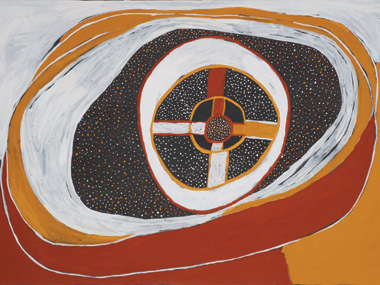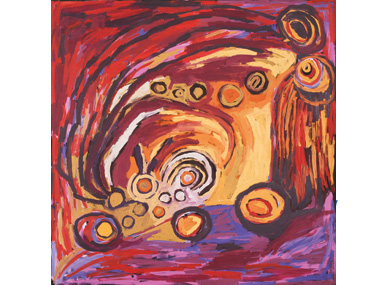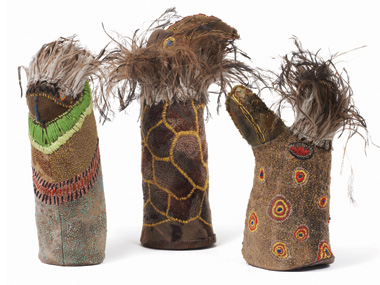The 29th NATSIAAs

TELSTRA AWARD $40,000 Timothy Cook, Kulama, Natural pigments on linen
Aboriginal Art Directory | 10.08.12
Author: Jeremy Eccles
“It's a really interesting year, I think – characterised by strong women. Where have artists like Cornelia Tipuamantumeri, Barbara Moore and Rhonda Sharpe suddenly come from? Pow!!”
Very new Curator of Indigenous Art at the Museum & Art Gallery of the NT (MAGNT) – John Waight – was summing up his feelings about the 29th annual National Aboriginal & Torres Strait Islander Art Awards (the NATSAAs) at the Museum in Darwin – for many, the highlight of the Aboriginal art year. Waight joined the party just in time to hang the 63 finalists (from 280 entries) – but the judging was done by WA curator Glenn Pilkington (a powerful man, as he also selected the WA Indigenous Art Award finalists), artist/photographer Bindi Cole from Melbourne, and academic Roger Benjamin.
New MAGNT Director, Pierre Arpin called Waight's hang “beautiful and intelligent”. And, after a series of bureaucrats running this institution, it's good to have some art professionalism at the helm. Arpin's praise for Waight is just. Far too often in the past we've had art ghettos at the NATSIAAs – rooms full of barks, urban art or hot APY desert canvases . For the first time in my experience each work – especially the barks – is given its individual due.
Mind you, it's just possible that the positioning of the Big Telstra winner (of $40,000) by Timothy Cook so that his 'Kulama' (Yam Dreaming) hits you in the eye as you enter the galleries could have contributed to its finding favour. For, just round the corner, out of sight, was my absolute 'steal' Barbara Moore's (from Tjala Art at Amata) 'Untitled' (Fish Dreaming story) from the desert. Using a much bigger brush than her elders like the great Hector Burton – also on show – she happily told me she “wants to make big marks – like being back at school”. And a combination of that infectious energy with her colour sense and the effect of sucking the eye into a vortex won her the Telstra General Painting Award.
Another interpretation might have it that the judges – coming from three very different ends of the art spectrum – came to agreement on the subject of yams! For, as well as Timothy Cook's masculine view of the yam as a reflection of male coming-of-age ceremonies on the Tiwi Islands (triggered by a particular phase of the moon), the Telstra Bark Painting Award went to Djirrirra Wungumurra's self-portrait as a yam, 'Yukuwa'. Her work offers the distaff side of the coin – the yam as food source, as prevention for diabetes and as symbol of Yolgnu inter-connectedness in NE Arnhemland, seen in the complexity of the root structure – once a feature of the great Emily Kngwarreye's work.
It's almost unnecessary to say that Wungumurra comes from the outstanding Buku Larrnggay art centre in Yirrkala, which had seven finalists in all. Two of them also reflected that male/female thing observed above – Djambawa Maruwili and Liyawaday Wirrpunda, his third wife, hung barks of matching size and all-but matching quality.
It seemed, however, from hints by the judges (and a Highly Commended award) that the work which most threatened Wungmurra's win was yet another Buku bark by the artist of the year, Nyapanyapa Yunupingu. As her once-dominant sister Gulumbu was sadly dying, she was seemingly stepping up to strike a quadrella at the NATSIAAs, the WA indigenous Art Awards, the Sydney Biennale and the National Gallery's Triennial. Here she's tackled the Seven Sisters Dreaming from the stars with her own, highly personal mark-making – a bark covered in Expressionist flowers.
How interesting, though, to trace Indigenous respect for the heavens from Yirrkala across to Solomon Booth's Torresian increase/navigation story, over to Timothy Cook's moon cycling, and down to Sylvia Kanytjupi Ken's desert story-telling. It can only happen at a national event like the NATSIAAs.
Which brings me to the Wandjuk Marika Memorial 3D Award – handed to Jack Nawilil's mystic black pole, 'Namorrodo'. He's from Maningrida in W Arnhemland. It's the Lightning Man from the Wet – created innovatively from bush string bound tightly round paper-bark – the string dyed a midnight purple, using a bush onion 'from my country' for the colour. A month's dedication, reportedly, was required for the process.
What a contrast with old Anangu man Ben Holland. Here is short-hand....fragments of complexity – like a kid's work, bored by the nicities, concentrating on the essence – and only filling 50% of the canvas with bold colour. It must have taken courage by the pre-selectors (as with Nawailil's pole) to pick this one from a photo – as they have to back in April.
Those pre-selectors, by the way, decided that the three New Media works offered didn't justify themselves for the award category. Instead, a 'conversation' will be held later this year on ways to encourage more/better work. But do they need to look further than one ineligeable entry this year – the work of totally unsupervised kids at the Buku Mulka Media Center who hacking into its systems in order to show off their transgressive selves. Nine screens hanging from trees at tonight's Awards Ceremony will reveal (almost) all!
Would Raymond Zada approve? The Telstra Work on Paper winner from Adelaide has a computer-generated work, 'Racebook' which mocks the ease with which race hate is generated on Facebook, and the ease with which it's discreetly removed – though the hate lingers in the perpetrators' minds. Let's not forget the recent Sikh temple killings in the US.
Complex ideas, though perhaps not an amazing artwork – the title word made up from many scabrous comments. I think I'd have turned to Michael Cook, another Triennial star, with a funny/sad photo-montage of vehicular discrimination in practice – the Queen and a corgi in one train carriage, a mob of Indigenous faces crammed into another!
So what of the other two new names lauded by curator John Waight – Cornelia Timpuamantumeri and Rhonda Sharpe?
Cornelia is a Manupi artist from the Tiwi islands – and her's is almost as radical a work as winner Timothy Cook's in terms of re-writing the Islands' ochred dots and dashes. Her daring captures the ebb and flow of the tides that play such a key role in an island's culture.
Rhonda Sharpe, on the other hand is a Luritja woman from Larapinta who's simply stuffed three 'Night Birds' then embroidered their skins and feathered their heads – such feminine tactics for such a bold masculine result.
So much else I could talk about in the art and its selection But an intriguing sideshow emerged in the absence of any of the more loud-spoken urban artists from the show – the Ah Kees, Bells and Rennies. It seems they may no longer consider themselves 'Aboriginal artists', and therefore boycotted the NATSIAAs. This, of course, is a development I've been mulling over in several posts on this site during 2012.
The NATSIAAs will survive – especially as Telstra has come to this important party for another three years. That'll make it a 24 year relationship – all too rare in the world of arts sponsorship. By the way, Telstra's Chief Sustainability Officer also mentioned that 400 Telstra shops will start to display signs acknowledging prior Aboriginal ownership of the land where they stand. Good on them!
LIST OF WINNING ARTISTS
TELSTRA AWARD $40 000
Timothy Cook, Kulama, Natural pigments on linen
TELSTRA GENERAL PAINTING AWARD $4 000
Barbara Moore, Untitled, Synthetic polymer paint on linen
TELSTRA BARK PAINTING AWARD $4 000
Djirrirra Wunungmurra, Yukuwa, Natural pigments on bark
TELSTRA WORK ON PAPER AWARD $4 000
Raymond Zada Racebook, Giclée print on Hahnemuhle FineArt photo rag
WANDJUK MARIKA MEMORIAL 3D AWARD (SPONSORED BY TELSTRA) $4,000
Jack Nawilil, Namorroddo, Paperbark, bush string, natural pigments, beeswax, feathers
HIGHLY COMMENDED
TELSTRA GENERAL PAINTING AWARD
Lydia Balbal Jawani Jawani, Synthetic polymer paint on linen
TELSTRA BARK PAINTING AWARD
Nyapanyapa Yunupingu, Djulpan, Natural pigments on bark
TELSTRA WORK ON PAPER AWARD
Mersane Loban, Paiyaga, Ink on paper
WANDJUK MARIKA MEMORIAL 3D AWARD
Rhonda Sharpe, Night Birds, Fabric, feathers, synthetic, polymer paint
The 29th Telstra National Aboriginal & Torres Strait Islander Art Award exhibition will be on display at the Museum and Art Gallery of the Northern Territory until Sunday, 28 October 2012.
Share this:
»  del.icio.us
»
del.icio.us
»  Digg it
»
Digg it
»  reddit
»
reddit
»  Google
»
Google
»  StumbleUpon
»
StumbleUpon
»  Technorati
»
Technorati
»  Facebook
Facebook
Contact Details

TELSTRA GENERAL PAINTING AWARD $4,000 Barbara Moore, Untitled, Synthetic polymer paint on linen

HIGHLY COMMENDED Rhonda Sharpe, Night Birds, Fabric, feathers, synthetic, polymer paint
Further Research
Artists: Barbara Moore | Rhonda Sharpe | Timothy Cook
News Tags: 29th NATSIAAs | Barbara Moore | Rhonda Sharpe | Timothy Cook
News Categories: Feature
News Archive
- 11.10.17 | RETURN OF MUNGO MAN
- 10.10.17 | TARNANTHI 2017
- 11.08.17 | Natsiaas 2017
- 08.08.17 | ABORIGINAL ART ECONOMICS
- 02.08.17 | SCHOLL'S NEXT MOVE
- 20.07.17 | APY ART DOMINATES THE WYNNE
- 17.07.17 | Anangu Artist Wins $100,000 Prize
- 14.07.17 | The End of AAMU
- 13.07.17 | YOU ARE HERE
- 11.07.17 | ART ACROSS THE COUNTRY
- 11.07.17 | TARNANTHI IN OCTOBER
- 05.07.17 | TJUNGUṈUTJA - from having come together
- 02.07.17 | BENNELONG
- 27.06.17 | JIMMY CHI
- 23.06.17 | Blak Markets at Barangaroo
Advertising

